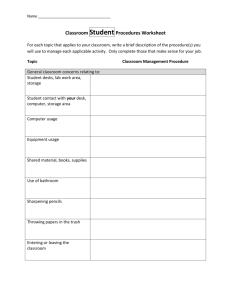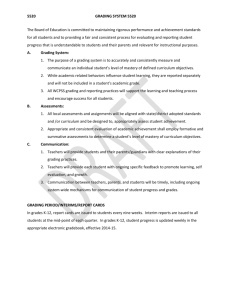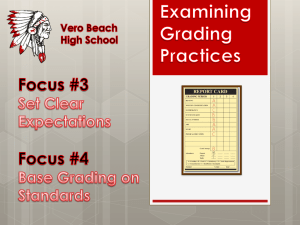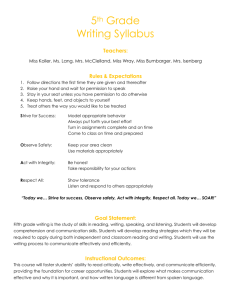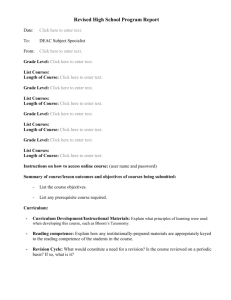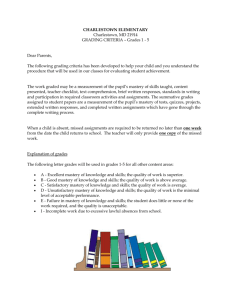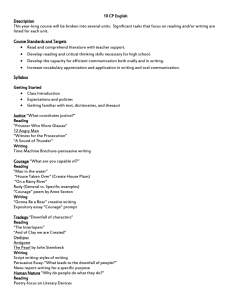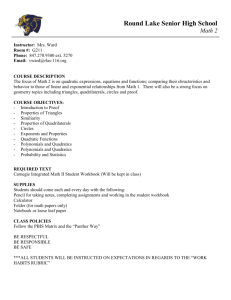School Supplies:
advertisement
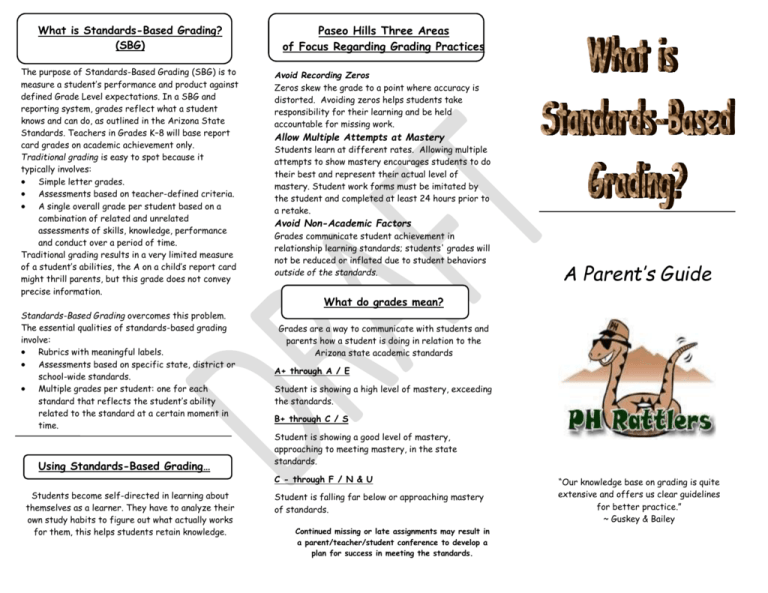
What is Standards-Based Grading? (SBG) The purpose of Standards-Based Grading (SBG) is to measure a student’s performance and product against defined Grade Level expectations. In a SBG and reporting system, grades reflect what a student knows and can do, as outlined in the Arizona State Standards. Teachers in Grades K–8 will base report card grades on academic achievement only. Traditional grading is easy to spot because it typically involves: Simple letter grades. Assessments based on teacher-defined criteria. A single overall grade per student based on a combination of related and unrelated assessments of skills, knowledge, performance and conduct over a period of time. Traditional grading results in a very limited measure of a student’s abilities, the A on a child’s report card might thrill parents, but this grade does not convey precise information. Standards-Based Grading overcomes this problem. The essential qualities of standards-based grading involve: Rubrics with meaningful labels. Assessments based on specific state, district or school-wide standards. Multiple grades per student: one for each standard that reflects the student’s ability related to the standard at a certain moment in time. Using Standards-Based Grading… Paseo Hills Three Areas of Focus Regarding Grading Practices Avoid Recording Zeros Zeros skew the grade to a point where accuracy is distorted. Avoiding zeros helps students take responsibility for their learning and be held accountable for missing work. Allow Multiple Attempts at Mastery Students learn at different rates. Allowing multiple attempts to show mastery encourages students to do their best and represent their actual level of mastery. Student work forms must be imitated by the student and completed at least 24 hours prior to a retake. Avoid Non-Academic Factors Grades communicate student achievement in relationship learning standards; students' grades will not be reduced or inflated due to student behaviors outside of the standards. What do grades mean? Grades are a way to communicate with students and parents how a student is doing in relation to the Arizona state academic standards A+ through A / E Student is showing a high level of mastery, exceeding the standards. B+ through C / S Student is showing a good level of mastery, approaching to meeting mastery, in the state standards. C - through F / N & U Students become self-directed in learning about themselves as a learner. They have to analyze their own study habits to figure out what actually works for them, this helps students retain knowledge. A Parent’s Guide Student is falling far below or approaching mastery of standards. Continued missing or late assignments may result in a parent/teacher/student conference to develop a plan for success in meeting the standards. “Our knowledge base on grading is quite extensive and offers us clear guidelines for better practice.” ~ Guskey & Bailey How can we work together? Grade Level Snapshots Teacher Responsibilities: Design assignments and assessments that meet the learning objectives Provide timely feedback and communication to students and parents so that progress on each Kindergarten – Second Grade Homework is for practice only Multiple re-assessments for mastery or not attempted 49% used for assignments missing or not attempted 50% used for assignments or assessments receiving Provide opportunities for students to display learning in a variety of ways Student Responsibilities: Request help to understand concepts that are misunderstood Complete all assignments in a timely manner Initiate a plan with teacher to redo assignments Third Grade – Eighth Grade 49% used for assignments missing or not attempted 50% used for assignments or assessments receiving less than 50% Complete homework—do not rush to complete it, but use it as practice to learn concepts for assessments Arrange for time to redo assessments Retakes must be student initiated; parent must Communicate regularly with your child about Help with time management to ensure that all assignments get completed on time Review completed work Provide a suitable study environment Sign necessary assessments to allow student to exams). Retakes must be completed within two weeks Use Power School to monitor student’s progress on each content standard Updated August 2, 2013 Summative assessments (oral & written tests, projects, presentations, etc.) are also used to measure student’s progress. Summative assessments provide evidence of learning. These “summarize learning.” 0's are not given for missing assignments, instead a 49% is put in the grade book until the assignment is turned in. Assignments or assessments receiving less than 50% are put into the grade book as a 50% until the assignment or assessment has been redone. Redo's are encouraged and expected on assignments and assessments that students have shown less than mastery. Students must imitate the retake process independently and complete a student work form 24 hours prior to a retake. Effort, participation, and attitude will not be included in final grades, but may be reported on the report card. Rubrics/project sheets will be used for students & parents to understand expectations for assignments. Extra credit and grading on a curve are not used; these practices are not an effective way to show mastery of standards of a grade reported in PowerSchools. Homework and practice will be collected as part of feedback and relearning opportunities Scale: A = 90-100% B = 80-89% C = 70-79% D = 60-69% retest practice and relearning (excluding end of quarter/term his/her progress Formative assessments (homework, class work, observations, rough drafts, and work samples) are practice used to measure progress and to provide effective feedback of progress. These “inform learning.” reassessments will be permitted following proof of Parent Responsibilities: acknowledge awareness of retake. Multiple Redo assignments that show mastery of standards to show exceeding/excelling of standards Feedback through checklists, comments, & rubrics will be given to students to keep track of their progress assessments are given standard After relearning, opportunities for multiple re- and assessments that show less than mastery of a less than 50% content standard can be monitored Grading Understandings: F = 50-59% F = 49% Proficient work on all content objectives and advanced work on most or all objectives. Proficient work on all content objectives, and advanced work on some objectives. Proficient work on all content objectives. Proficient work on at least 60% of the content objectives but missing objectives and is at significant risk of failing. Proficient work on at least ½ of the content objectives and is failing. No attempt made, missing work
